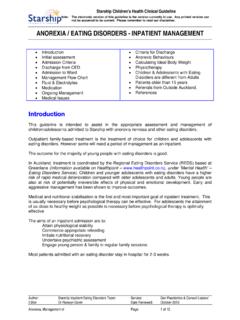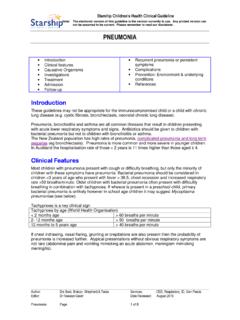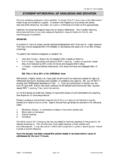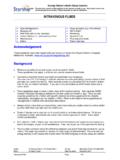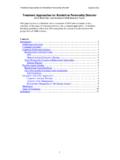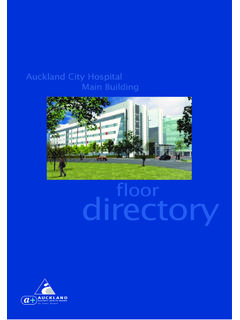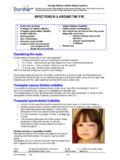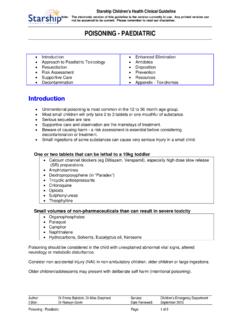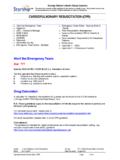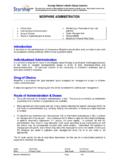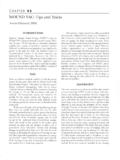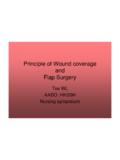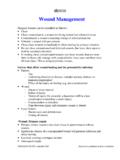Transcription of LACERATIONS – ASSESSMENT & MANAGEMENT
1 Starship Children s Health Clinical Guideline Note: The electronic version of this guideline is the version currently in use. Any printed version can not be assumed to be current. Please remember to read our disclaimer. LACERATIONS ASSESSMENT & MANAGEMENT Author: Dr Sinan Kamona, Dr Michael Shepherd Service: Children s Emergency Department Editor: Dr Raewyn Gavin Updated: October 2013 Laceration Page: 1 of 6 Introduction ASSESSMENT Wound Irrigation Local Anaesthesia Debridement Procedural Sedation MANAGEMENT of Specific Types of Wound Methods of Closure Dressings and Splints Other Treatment Links to Patient Advice Sheets References Introduction Minor LACERATIONS are extremely common in childhood. There are a variety of MANAGEMENT options which need to balance distress to the child with functional and cosmetic results. Many wounds can be managed without suturing.
2 Best results are achieved in children who are cooperative and not frightened. It is important to maintain a child friendly environment. Involve caregivers, play specialists and nursing staff. Local anaesthesia and/or sedation may be necessary for the MANAGEMENT of some LACERATIONS in the ED. If adequate MANAGEMENT cannot be achieved in the ED, then referral to an inpatient service for general anaesthesia may be required. ASSESSMENT Consider the following: Mechanism of Injury: Are there likely to be other injuries? (such as to the head or cervical spine in falls, or to the teeth with injuries to the mouth). Contamination: Is the wound likely to be contaminated by dirt or a foreign body? Obtain radiographs if there is suspicion of retained radio-opaque foreign bodies. Deeper Structures: Always consider the possibility of injury to structures such as tendons and nerves. If a deep laceration cannot be examined adequately, general anaesthesia may be required.
3 Blood Supply: If a flap or area of soft tissue distal to the laceration appears dusky or poorly perfused, the wound requires specialist ASSESSMENT . Areas with end-arteriolar supply such as the tip of the nose, finger tips, and ear lobes require special care. Special Areas: Certain areas require accurate repair for adequate closure and cosmetic result. Such cases can often be repaired in the ED but some will require referral for specialist repair and/or general anaesthesia. It is recommended that these cases are discussed with the ED SMO prior to active MANAGEMENT . Starship Children s Health Clinical Guideline Note: The electronic version of this guideline is the version currently in use. Any printed version can not be assumed to be current. Please remember to read our disclaimer. LACERATIONS ASSESSMENT & MANAGEMENT Author: Dr Sinan Kamona, Dr Michael Shepherd Service: Children s Emergency Department Editor: Dr Raewyn Gavin Updated: October 2013 Laceration Page: 2 of 6 Examples of these injuries include: - LACERATIONS which cross the vermilion border of the lip or the hairline of the eyebrow.
4 - LACERATIONS involving the nasal alar margin. - Complex LACERATIONS of the ear. - LACERATIONS of the eyelid which cross the margin of the lid, involve the tarsal plate, medial canthus or lachrymal apparatus should be referred to Ophthalmology for repair. Wound Irrigation All wounds should be cleaned. Irrigation rids the wound of contaminants, debris and bacteria and is considered the most important means of reducing the incidence of wound infection. It is very difficult to achieve adequate wound irrigation without local anaesthesia and/or sedation. Some simple, small and superficial wounds can be managed with just a small amount of irrigation without anaesthetic. Deep wounds, contaminated wounds and bites need especially copious irrigation prior to closure. There is little evidence to support the use of one particular irrigation fluid over another, however normal saline is most commonly used.
5 Evidence suggests that potable tap water is just as effective. Chlorhexidine and iodine containing solutions are unnecessary and may interfere with wound healing, but can be applied to the intact skin surrounding the wound. Povidine-iodine concentrations greater than 1% should not be used. Do not use chlorhexidine or iodine containing solutions near the eyes. The volume used depends on the size, location and depth of the wound in addition to the mechanism of injury. This will range from as little as 10 to 20 millilitres for small clean wounds in highly vascular areas ( small superficial LACERATIONS of the face) to 1 to 2 litres for deeper contaminated wounds. As a guide, use 50 to 100ml for each centimetre of laceration. To achieve adequate irrigation pressure, use a syringe attached to a 20G catheter. A shield with an appropriately sized nozzle can be used instead and will offer protection against splashback ( the Zerowet SupershieldTM).
6 Local Anaesthesia This may be topical or infiltrated. Please see the separate guideline Local Anaesthesia for Minor Procedures. Starship Children s Health Clinical Guideline Note: The electronic version of this guideline is the version currently in use. Any printed version can not be assumed to be current. Please remember to read our disclaimer. LACERATIONS ASSESSMENT & MANAGEMENT Author: Dr Sinan Kamona, Dr Michael Shepherd Service: Children s Emergency Department Editor: Dr Raewyn Gavin Updated: October 2013 Laceration Page: 3 of 6 Debridement Once the wound is adequately anaesthetised and irrigated, devitalised wound edges should be debrided using sharp scissors and/or a scalpel blade. Irrigate the wound again after debridement to remove tissue debris. Procedural Sedation The options for procedural sedation in the Children s ED are usually limited to ketamine and continuous nitrous oxide.
7 Self-administered nitrous oxide (entonox) may be an option in older children with the aim to achieve local anaesthetic infiltration without distress. Benzodiazepines are unpredictable and best avoided. It is imperative that adequate staffing is present and departmental protocols adhered to. Please discuss all cases potentially suitable for procedural sedation with the ED SMO. MANAGEMENT of Specific Types of Wound LACERATIONS of the oral mucosae and tongue: These heal rapidly and only require sutures if very extensive, gaping or have persistent bleeding. Hands: Full thickness hand LACERATIONS under 2cm in length which do not involve deeper structures are likely to be suitable for irrigation and dressings alone. Finger Tips: Small LACERATIONS with skin loss at the finger tips are very common. Areas of skin loss up to 1cm2 are treated with dressings and heal with good return of sensation.
8 Any greater degree of tissue loss should be referred to the Orthopaedic service. Soft tissue flaps at the ends of fingers can be managed with steristrips and dressings; sutures are best avoided as they can impair perfusion of the distal flap. X-rays to check for fracture of the distal phalanx should be performed and the child referred to the Orthopaedic service if this type of compound fracture is present. Nailbed Injuries: These may require definitive repair involving removal of the nail. Depending on available resources and expertise, these may be repaired in ED or referred to the Orthopaedic team for repair under general anaesthesia. Please discuss with the ED SMO if unsure. Puncture Wounds: are usually best left open although they may require exploration or debridement if deep or contaminated. Bites: Most bites in New Zealand are caused by dogs, cats and other humans. o Look for associated injuries, crush injuries from a large dog bite, and bites or scratches elsewhere.
9 Consider x-rays for retained teeth. Consider the possibility of non-accidental injury in human bites. o All bites should be copiously irrigated and examined for deeper injury. Devitalised wound edges should be debrided. Starship Children s Health Clinical Guideline Note: The electronic version of this guideline is the version currently in use. Any printed version can not be assumed to be current. Please remember to read our disclaimer. LACERATIONS ASSESSMENT & MANAGEMENT Author: Dr Sinan Kamona, Dr Michael Shepherd Service: Children s Emergency Department Editor: Dr Raewyn Gavin Updated: October 2013 Laceration Page: 4 of 6 o Primary closure is usually reserved for bites less than 12 hours old (24 hours on the face), which have been adequately irrigated/debrided. Dog bites have lower infection risk than cat or human bites, so are more amenable to primary closure. Sutures, rather than tissue adhesive, should be used for the primary closure of bite wounds.
10 Try to avoid deep sutures. o In general, puncture wounds (this includes most cat bites) and bites to the hand should not undergo primary closure. Allowing the bite to heal by secondary intention is a good option for small bites in non-cosmetic areas. Alternatively delayed closure can be arranged ( at 72 to 96 hours) in liaison with the appropriate inpatient surgical team. o Antibiotics for bite wounds: Superficial human and dog bites which have been irrigated within 12 hours of the injury and which do not require primary closure do not need antibiotic prophylaxis. Bites to the hand are associated with a greater rate of infection and antibiotics are usually prescribed, with a low threshold for referral to the orthopaedic team. Other animal bites (including cats) and more severe wounds should be given antibiotic prophylaxis. amoxicillin/clavulanic acid is typically prescribed.
